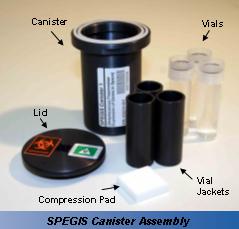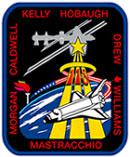SPEGIS (STS-118)
Streptococcus pneumoniae Expression of Genes in Space
The Streptococcus pneumoniae Expression of Genes in Space (SPEGIS) experiment investigated the effects of the space environment on the gene expression and production of important virulence proteins of the human bacterial pathogen Streptococcus pneumoniae.
Experiment Relevance
It is well established that bacteria thrive in the orbiting spacecraft. Many of these bacteria were identified as pathogens, including Streptococcus species. S. pneumoniae is a respiratory microbe that is normally found in the upper respiratory tract of approximately 40% of the healthy human population. It is an opportunistic bacterium that will cause a debilitating disease under the appropriate conditions, such as in individuals with a weakened immune system. Despite being the subject of many decades of investigation, the process of how S. pneumoniae infects people and causes disease are still poorly understood. The objective of SPEGIS was to examine S. pneumoniae growth properties in microgravity and identify molecular processes that may change in the space flight environment. Specifically, virulence factors expression and changes in global gene expression were investigated. The identification of genes whose expression changes in this environment may identify the factors and biological pathways that govern S. pneumoniae infection and disease. Furthermore, the identifications of these genes may provide new targets for the development of novel antibiotics that can be used on Earth and in space.
Payload Overview
The SPEGIS microbiology experiment payload was transported to the International Space Station on STS-118/13A.1, which launched on August 8, 2007. The payload supported the NASA-sponsored research of Dr. David Niesel, University of Texas Medical Branch, Galveston. Dr. Niesel’s experiment investigated the effects of the space environment on the gene expression and production of important virulence proteins of the human bacterial pathogen S. pneumoniae. The experiment was conducted aboard the space station and then returned to Earth on August 21, 2007.
All launch site ground activities were conducted at the Space Life Science Laboratory at NASA’s Kennedy Space Center in Florida. Before launch, nine 8-mL polypropylene vials were filled with different concentrations of S. pneumoniae. Each filled vial was inserted into an aluminum jacket. The function of the jacket was to improve thermal transfer to allow efficient cooling and heating of the bacteria cultures in microgravity. The vial/jacket assembly was inserted into three canisters (NASA’s Ames Research Center, Flight Systems Implementation Branch.). The loaded canisters were installed into a powered Microgravity Environment Research Locker/INcubator (MERLIN; Center for Biophysical Sciences and Engineering, University of Alabama, Birmingham), which was set to +4 °C to maintain the bacteria in growth status. The MERLIN was turned over for installation in the Middeck of the Orbiter at launch minus 8 hours.
After launch, the bacteria were maintained at +4 °C and then transferred to Minus Eighty Laboratory Freezer for ISS (MELFI) for stowage at +4 °C until the start of the experiment. The canisters were incubated in the MERLIN at +37 °C. At the end of the incubation duration all of the canisters was transferred from MERLIN to the MELFI -95 °C dewar. For descent, the frozen canisters were transferred to a Double Coldbag filled with pre-frozen -32 °C ICEPACs. Astronauts Charlie Hobaugh (Pilot) and Barbara Morgan (Mission Specialist) conducted the experiment procedures aboard the station. The canisters were returned to Earth after 13 days in space. A delayed ground control was conducted that replicated all procedures of the flight experiment. The ground control used a MERLIN and JSC Double Coldbag/ICEPACS. A laboratory cryo-freezer and refrigerator were used to simulate MELFI. The start of the ground control was offset from the flight experiment by 48 hours to allow for replication of all crew operations to the actual on-orbit timeline.
Project Team
Principal Investigator: Dr. David Niesel, University of Texas Medical Branch, Galveston
Project Manager: Kristina Gibbs, Lockheed Martin, Ames Research Center
Deputy Project Manager/Operations Lead: Steven Ormsby, Lockheed Martin, Ames Research Center
Project Scientist: Dr. Hami Teal, NASA, Ames Research Center
Payload Scientist: Dr. Kevin Sato, Lockheed Martin, Ames Research Center
Project Engineer: Lance Ellingson, Lockheed Martin, Ames Research Center
Logistics Lead: Karin Perkins, Lockheed Martin, Ames Research Center
SS&MA: Ken Zander and Bob Burney, NASA, Ames Research Center
For more information, see the Space Station Research Explorer for the STS-118/SPEGIS mission.




































